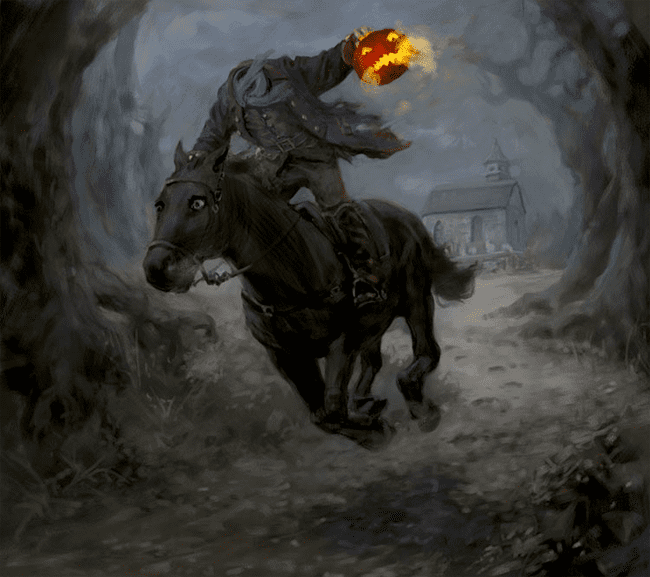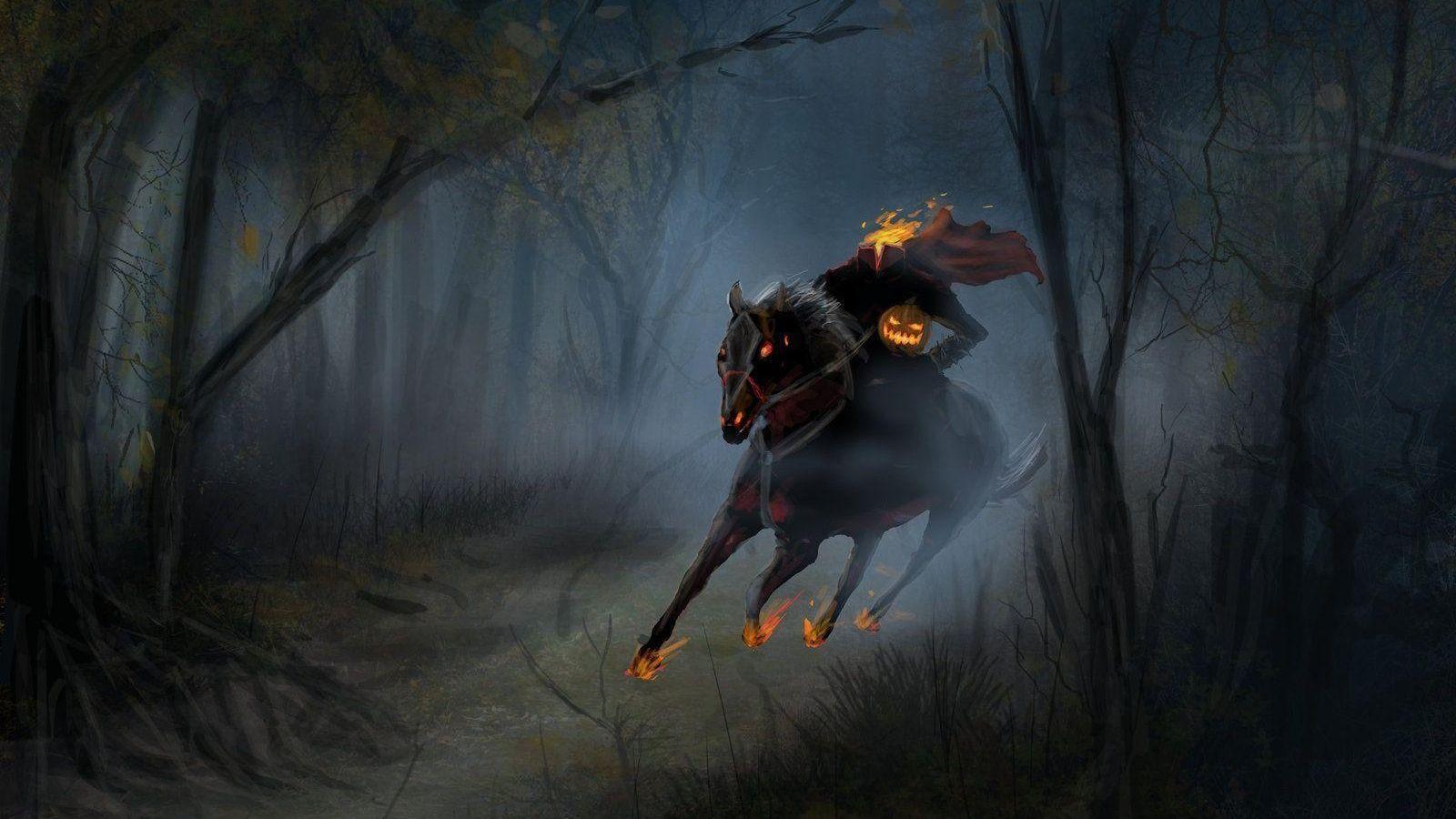The legend of the headless horseman has fascinated generations, weaving a tale of mystery and horror that transcends time and culture. Rooted in folklore and popularized through literature and film, this enigmatic figure continues to captivate audiences worldwide. From its origins in European myths to its adaptation in Washington Irving's "The Legend of Sleepy Hollow," the headless horseman's story has evolved into a cultural phenomenon that resonates with people of all ages.
As we delve deeper into the history of the headless horseman, it becomes apparent that this figure represents more than just a ghostly rider without a head. It symbolizes themes of fear, justice, and the unknown, striking a chord with those who seek to understand the darker aspects of human nature. This article explores the origins, adaptations, and cultural significance of the headless horseman, shedding light on why this legend remains so powerful today.
For those intrigued by the supernatural and the macabre, the headless horseman's tale offers a rich tapestry of stories and interpretations. By examining its roots and evolution, we can gain a deeper appreciation for how folklore shapes our collective imagination and influences modern storytelling. Let us embark on a journey through time and culture to uncover the enduring appeal of this timeless legend.
Read also:Fairfield Inn Orangeburg Sc Your Ultimate Stay In South Carolina
Who Was the First Headless Horseman?
The origins of the headless horseman can be traced back to various European legends, with Ireland's Dullahan and Germany's Wild Huntsman being among the earliest known versions. These stories often depicted a headless rider seeking vengeance or justice, riding through the night with supernatural speed. The Irish Dullahan, in particular, was said to carry its severed head, using it to illuminate its path as it searched for souls to claim.
As these tales spread across Europe, they merged with local folklore, creating unique variations of the headless horseman. Each culture added its own twist to the legend, reflecting their beliefs and fears about death and the afterlife. This adaptability allowed the headless horseman to remain relevant, resonating with people across different regions and eras.
What Role Did Washington Irving Play in Popularizing the Headless Horseman?
Washington Irving's "The Legend of Sleepy Hollow" played a pivotal role in bringing the headless horseman to a global audience. Published in 1820, this short story introduced the character of Brom Bones and the mysterious figure of the headless horseman, forever cementing its place in American literature. Irving's vivid descriptions and masterful storytelling brought the legend to life, capturing the imagination of readers worldwide.
Irving's version of the headless horseman incorporated elements from both European folklore and American frontier life, creating a unique blend of old-world mysticism and new-world adventure. This fusion of traditions contributed to the character's enduring appeal, making it a staple of Halloween celebrations and horror stories.
How Has the Headless Horseman's Story Evolved Over Time?
As the legend of the headless horseman traveled across continents, it underwent numerous transformations, adapting to fit the cultural contexts of each new audience. In the 20th century, the character found new life in film and television, with adaptations like Tim Burton's "Sleepy Hollow" and the animated series "The Legend of Sleepy Hollow" bringing the story to new generations. These modern interpretations often emphasized the headless horseman's role as a symbol of fear and the unknown, resonating with contemporary audiences.
Beyond literature and film, the headless horseman has also inspired countless works of art, music, and theater, further cementing its place in popular culture. Each new adaptation adds depth and complexity to the legend, ensuring its continued relevance in an ever-changing world.
Read also:Sylvester Stallone Relationships A Deep Dive Into His Love Life And Personal Journey
Biography of Washington Irving
Before exploring the headless horseman's cultural impact, it is essential to understand the life and works of Washington Irving, the man who popularized this legendary figure. Below is a brief overview of Irving's biography and key contributions to literature:
| Full Name | Washington Irving |
|---|---|
| Date of Birth | April 3, 1783 |
| Place of Birth | New York City, USA |
| Occupation | Author, Essayist, Diplomat |
| Notable Works | The Legend of Sleepy Hollow, Rip Van Winkle |
Why Does the Headless Horseman Fascinate People?
One of the reasons the headless horseman continues to captivate audiences is its ability to tap into universal themes of fear and mystery. The image of a rider without a head evokes a primal fear of the unknown, resonating with people across cultures and generations. This timeless appeal lies at the heart of the legend's enduring popularity.
In addition to its symbolic power, the headless horseman also serves as a cautionary tale, warning against greed, dishonesty, and other vices. Its pursuit of justice, whether real or imagined, adds another layer of intrigue to the story, making it a rich source of inspiration for storytellers and artists alike.
Can the Headless Horseman's Legend Be Traced to Real Events?
While the headless horseman is largely a product of folklore and fiction, some historians have speculated that its origins may lie in real events or historical figures. For example, the story of the Wild Huntsman in German folklore is believed to have been inspired by tales of Hessian soldiers during the American Revolutionary War. These soldiers, known for their fierce reputation, may have served as the basis for the headless horseman's character in "The Legend of Sleepy Hollow."
Despite these connections, the headless horseman remains largely a fictional creation, its power lying in its ability to evoke fear and wonder in equal measure. This blend of reality and imagination is what makes the legend so compelling and enduring.
Headless Horseman's Impact on Popular Culture
The influence of the headless horseman extends far beyond literature and film, permeating various aspects of popular culture. From theme park attractions to Halloween costumes, this legendary figure has left an indelible mark on modern society. Its enduring appeal lies in its ability to adapt to new contexts while retaining its core elements of mystery and horror.
- Theme park rides featuring the headless horseman
- Halloween costumes inspired by the character
- Merchandise and collectibles based on the legend
How Has the Headless Horseman's Legacy Shaped Modern Storytelling?
As a symbol of fear and the unknown, the headless horseman has inspired countless works of fiction, both in print and on screen. Its influence can be seen in modern horror stories, where themes of vengeance and justice often take center stage. By examining the headless horseman's legacy, we gain insight into how folklore shapes contemporary storytelling and continues to resonate with audiences today.
Moreover, the headless horseman's ability to evolve with the times highlights the importance of adaptability in maintaining cultural relevance. As new technologies and mediums emerge, the legend continues to find new ways to captivate and terrify, ensuring its place in the annals of horror and folklore for generations to come.
What Lessons Can We Learn From the Headless Horseman's Story?
At its core, the legend of the headless horseman offers valuable lessons about the human condition, exploring themes of fear, justice, and the unknown. By confronting these universal concerns, the story encourages us to reflect on our own fears and biases, fostering a deeper understanding of ourselves and the world around us.
In conclusion, the headless horseman's tale is more than just a ghost story; it is a powerful reminder of the enduring power of folklore to shape our collective imagination. As we continue to explore its origins and evolution, we gain a greater appreciation for how legends like the headless horseman's contribute to our cultural heritage and inspire future generations of storytellers.
Final Thoughts on the Headless Horseman's Legacy
In summary, the headless horseman's story remains a vital part of our cultural landscape, offering insights into the human experience while entertaining and terrifying in equal measure. By examining its origins, adaptations, and cultural significance, we deepen our understanding of how folklore shapes our perceptions and influences modern storytelling. Whether through literature, film, or other forms of media, the headless horseman's legacy continues to inspire and captivate audiences worldwide.
As we look to the future, it is clear that the headless horseman's tale will remain a source of fascination and inspiration, reminding us of the power of storytelling to connect us across time and culture. Through its enduring appeal, the legend of the headless horseman ensures that the mysteries of the past will continue to resonate with new generations for years to come.


